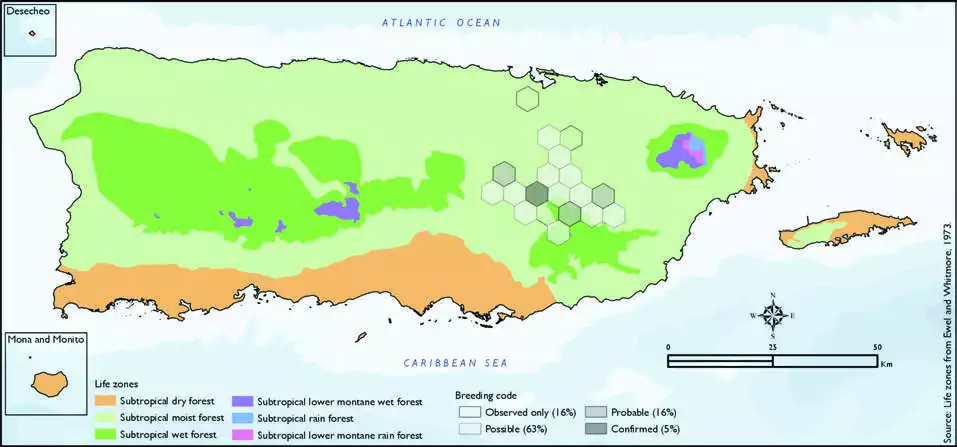Plain Pigeon
Description
The plain pigeon (Patagioenas inornata) is a species of bird in the family Columbidae. It is found in Cuba, Hispaniola (Dominican Republic and Haiti), Jamaica, and Puerto Rico. Its natural habitats are forest, woodland, coastal desert, mangrove and swampy areas. It is threatened by habitat loss.
The plain pigeon is a large-bodied bird (38 cm [15 in]) that superficially resembles the common city pigeon. At a distance it appears pale blue-gray overall. The head, hindneck, breast, and part of the folded wing are colored with a red-wine wash. When folded, the wing shows a white leading edge; in flight, it forms a conspicuous wing bar. Legs and feet are dark red. The female is slightly smaller and duller than the male. Juveniles are browner overall, with pale wing margins and dark eyes.
Distribution & Habitat
The Plain Pigeon is a species endemic to the Greater Antilles
where it is a common year-round
resident on Hispaniola and rare
on Cuba, Jamaica, and Puerto
Rico (Raffaele and others 1998).
In Puerto Rico, it occurs primarily in the east-central region near
Cidra and some neighboring
municipalities such as Comerío,
Caguas, Cayey, Aibonito, and San
Lorenzo (Oberle 2018, Rivera-Milán
and others 2003). It has not been
reported from the satellite islands.
This species usually inhabits open
savannas and woodlands, lowland
forest edges, mountain forests,
primary- and second-growth
forests, coastal areas, dry or wet
limestone forests, and agricultural
areas such as croplands and cattle
pastures (Collar and others 1992,
Collazo and Bonilla-Martinez
1988, Danforth 1936, PRDNER
1999, Raffaele and others 1998).
In Puerto Rico, the species can be
found mostly in wooded ravines, second-growth areas, bamboo
thickets, and patches of farmland
and pasture within moist mountain
forests (Collar and others 1992,
Collazo and Bonilla-Martinez 1988,
Oberle 2018, Rivera-Milán and
others 2003). The atlas fieldwork
yielded a total of 31 records within
19 hexagons or 4 percent of the
479 total hexagons (see map).
Of the 19 hexagons where the
Plain Pigeon was found, breeding
met the definition of confirmed
in 5 percent (1) of the hexagons,
probable in 16 percent (3), and
possible in 63 percent (12), while
it was observed in 16 percent
(3) of the hexagons but without
evidence of breeding (see map). Plain Pigeon distribution. The map shows the highest breeding code by hexagon and overlaying the ecological life zones in
Puerto Rico. Note: percentages may not total 100 due to rounding. 47Plain Pigeon/Paloma Sabanera

Breeding Habits
The Plain Pigeon builds a fragile nest made of sticks, twigs, leaves,
and other plant material, which
is usually placed in bamboo
clumps, vine clusters, palm fronds,
or hardwood trees (Biaggi 1997,
Oberle 2018, Raffaele and others
1998). Previously published
reports indicate that it breeds
throughout the year but primarily
from December to July (Oberle
2018). Atlas results suggest that this
species breeding season extends
mostly from February to July, with
the most breeding activity from
March through June, and to a
lesser extent from September to
November (see chart). Overall, the
breeding activity peaks in May, and
it mostly occurs in the subtropical
moist forest life zone. Results show
that this species breeds mostly in the east-central part of the
island within the subtropical moist
forest life zone (88 percent of the
hexagons) (see table and map).
Conservation
The Plain Pigeon is currently listed
as a near threatened species by the
IUCN (BirdLife International 2016).
Nevertheless, the Puerto Rican
subspecies (P. i. wetmorei) has
declined dramatically throughout
its distribution range and has
been considered endangered due
to habitat loss, illegal hunting,
and predation by introduced
mammals and hurricanes (Raffaele
and others 1998; Rivera-Milán
and others 2003, 2016). The
subspecies is believed to have
declined to <100 individuals in
the 1970s, but it has recovered
to several thousand individuals (Raffaele and others 1998, Rivera-
Milán and others 2003). Although
the Plain Pigeon population has
been found to decline following
hurricanes (Rivera-Milán and
others 2003, 2016), the population
has recovered quickly after
past hurricanes. However, the
population decreased substantially
following Hurricanes Irma
and María in September 2017
(Rivera-Milán and others 2019a).
The Puerto Rican subspecies is
classified as endangered by local
and Federal laws (PRDNER 2016
and USFWS 1973, respectively).
In Puerto Rico, the Plain Pigeon
subspecies has a protected
habitat in land of 5.2 percent or
20.1 km2 of the total area covered by the hexagons where evidence
of breeding was found for this
species (382 km2).
Related Species
Family:
pigeon